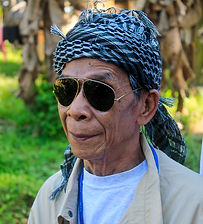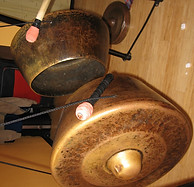

GAMABA
Virtual Art Exhibit
A
WORK OF
EXPLORING
life
THE
&
AHADAS
WANG
.jpg)
Uwang Ahadas was born in Lamitan, Basilan, Philippines on February 15, 1945. He went near-blind when he was 5 years old. It was said that the near-blindness of Uwang Ahadas was caused by the nature spirits as they were offended by his child plays. Hence, his blindness gave him a deep connection between himself and the instrument.
Furthermore, Uwang Ahadas started teaching his children how to play Yakan Traditional Instruments and then taught other students outside of Lamitan, Basilan. His many travels have blessed him with close and enduring ties with these people.
Declared as a National Living Treasure by the National Commission for Culture and the Arts in 2000 for his skill in playing Yakan musical instruments
The YAKANS
Uwang Ahadas is a Yakan. The Yakans live primarily in Basilan island of ARMM, Tipo-tipo, Lamitan, Sumisip and Tuburan. The Yakan have a wide range of musical instruments, the majority of which are percussion, but flutes and Jew's harps are also played. Percussion instruments are commonly heard and used at weddings and other significant life events. Farming is the Yakans' primary source of income, and they mostly produce upland rice. While the rice is growing, a particular instrument is played to make it happy so that it will yield a healthy harvest.
Tagunggu gong ensemble music is famous at weddings and other celebrations. Its lead instrument is kwintang, a row of “pot gongs' ' with similarities to the musical instrument of Indonesia used in Javanese gamelan.

Tagunggu Gong
Yakan
TRADITIONAL INSTRUMENTS



the kwintangan kayu is played to serenade the palay. It is said that its reverberation softly caresses the plants, waking them up from their deep sleep and encouraging them to grow and produce more fruit.
Kwintangan Kayu
a gong instrument used for
delivering announcements,
performing music in comb
ination with social events,
life cycle, discussions, and
festivities. One to three
agungs can be used depe
nding on the purpose or
stye.
Agung
commonly known as bamboo
xylophone in a form of trapez-
oidal shape which is a bamboo-
based musical instrument used
in the southern part of the
Philippines.
Gabbang
THE
philippines:
Uwang Ahadas
TRADITIONAL INSTRUMENTS
References:
-
Bangsamoro Commission for the Preservation of Cultural Heritage (n.d.). Yakan. Retrieved from: https://bch.bangsamoro.gov.ph/bangsamoro-cultural-heritage/bangsamoro-tribes-muslim/yakan/
-
Encyclopedia.com (n.d.). Yakan. Retrieved from: https://www.encyclopedia.com/humanities/encyclopedias-almanacs-transcripts-and-maps/yakan#:~:text=The%20Yakan%20have%20various%20musical,will%20give%20a%20good%20harvest.
-
Museomusiko (n.d.). Xylophones. Retrieved from: https://museomusiko.wordpress.com/idiophones/xylophones/
-
Layug, B. (2017). “Manlilikha ng Bayan (National Living Treasures)” Exhibit (Manila). Retrieved from: http://benjielayug.com/2017/10/manlilikha-ng-bayan-national-living-treasures-exhibit-manila.html
-
NCCA (n.d.). National Living Treasures: Uwang Ahadas. Retrieved from: https://ncca.gov.ph/about-culture-and-arts/culture-profile/gamaba/national-living-treasures-uwang-ahadas/
-
Story - Uwang Ahadas. Yakan. National Living Treasure: Project Larawan - Home. Retrieved from:https://projectlarawan.com/story/305/uwang-ahadas--yakan--national-living-treasure.html
Meet The Team

Rodil, Reianne Kathleen
.jpg)
Rubio, Harrold Dave D.

Santarin, Franchesca

Sena, Monivc
.jpg)